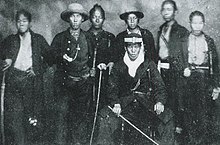Kiheitai
Kiheitai ( Japanese 奇兵 隊 , dt. "Command troop; irregular troop") was a volunteer militia, which was founded in 1863 by Takasugi Shinsaku in Chōshū (now Yamaguchi Prefecture ) in Japan to the regular troops in case of an attack on the Reinforce the daimyat by foreign troops or those of Bakufu . The unit was later commanded by Yamagata Aritomo . The troop consisted of 300 to 500 men who came not only from the samurai class, but from all social classes. The force was a significant force behind the Sonnō-jōi movement and played an important role in the Boshin War .
Background and origin
In the time of Bakumatsu , the Sonnō-jōi movement arose in Japan in response to the forced opening of Japan in the Treaty of Kanagawa and other unequal treaties that were perceived as humiliation . After the signing of the Harris Treaty in 1858, supporters of the movement began to radicalize themselves quickly in the Han Chōshū, Satsuma , Mito and Tosa and, under the leadership of Yoshida Shōin, openly advocate the violent overthrow of the shōgunate and the restoration of the power of the Tennō . As a result, there were several attacks on dignitaries of Bakufu and also on foreigners, an expression of xenophobia ( jōi ) of the rebel movement.
When the shogunate reacted to the increasing number of attacks by founding the Shinsengumi samurai militia , the military inferiority of the Sonnō-jōi rebels over government troops quickly became apparent. The Mito rebellion was put down in January 1865 by troops of the Shogunate, a punitive expedition of the Bakufu against Chōshū ended with the non-fighting submission of the Han. There were also tensions with the Western powers. Against this background, the Sonnō-jōi activists began to set up their own militias, the so-called shotai .
Structure and composition
With a strength of 300 to 500 men, the Kiheitai was the largest and best known of the Shotai .
The Kiheitai, like most other militias of the time, was composed of members of all classes. If they could entrust a deputy or heir with the field work, farmers were also accepted into the ranks of the Kiheitai. However, farmers who had fled their fields were not recruited and were regularly sent back. The unity was anti-feudal insofar as it recognized the need to free the peasants from the feudal yoke and to use the energies released in the fight against Bakufu. However, while some shotai were recruited from the peasantry to more than 70 percent, more samurai than commoners were found in the Kiheitai .
The use of modern western weapons gave the Kiheitai militiamen a tactical advantage over the samurai of the Tokugawa troops, who preferred traditional weapons such as bows and swords. The Kiheitai were also famous for their discipline and Western military tactics. As an "extraordinary" ( ki ) force, the Kiheitai pursued a tactic of surprise and attacked where and when the enemy did not expect them. The unit was also commanded by capable commanders such as Takasugi Shinsaku or Ōmura Masujirō , who is regarded as the founder of the Imperial Japanese Army .
The Kiheitai originally only served to support the regular Han troops and were initially used for the coastal protection of Chōshū.
Military operations
After the radical Sonnō-jōi activists from Chōshū and their supporters at the court of Kyoto were expelled from the imperial court by an alliance of samurai from Satsuma and Aizu in 1863 , the radicals from Chōshū marched again on Kyoto in August 1864 to re-serve the emperor Install rulers of Japan. However, the insurgents, supported by the Kiheitai , were stopped and defeated by the composite contingent of Satsuma and Aizu samurai in front of the Forbidden Gate. Radical noblemen who wanted to abolish the shogunate in favor of the emperor had to flee Kyōto.
The radical reformers from Chōshū suffered another serious setback in early September 1864 during the bombing of Shimonoseki after a coastal battery of the Kiheitai had opened fire on an Allied fleet.
After the re-establishment of the emperor in 1868, the Kiheitai was integrated into the army of the new government along with other units from Chōshū. As part of this army, she took part in the fighting against the Bakufu troops in the Boshin War .
Individual evidence
- ^ "Kiheitai", in: Janet Hunter (ed.): Concise Dictionary of Modern Japanese History , Berkeley 1984, p. 185
- ^ Hall, Jansen et al. (Ed.): The Cambridge History of Japan , Vol. 5. The Nineteenth Century, p. 343
- ^ "Kiheitai", in: Janet Hunter (ed.): Concise Dictionary of Modern Japanese History , Berkeley 1984, p. 185
- ^ E. Herbert Norman: Soldier and Peasant in Japan: The Origin of Conscription. In: Pacific Affairs , Vol. 16, No. 1 (1943), p. 62
- ^ Albert Craig: The Restoration Movement in Choshu. In: The Journal of Asian Studies , Vol. 18, No. 2 (1959), pp. 194f.
- ^ E. Herbert Norman: Soldier and Peasant in Japan: The Origin of Conscription. In: Pacific Affairs , Vol. 16, No. 1 (1943), p. 63
- ^ Edward J. Drea: Japan's Imperial Army. Its Rise and Fall, 1853-1945, University of Kansas Press, Lawrence 2009, p. 3.
